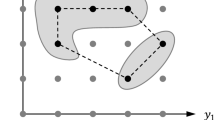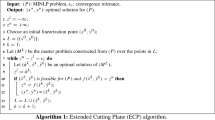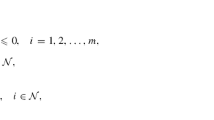Abstract
This paper presents branch-and-bound algorithms for the partial inverse mixed integer linear programming (PInvMILP) problem, which is to find a minimal perturbation to the objective function of a mixed integer linear program (MILP), measured by some norm, such that there exists an optimal solution to the perturbed MILP that also satisfies an additional set of linear constraints. This is a new extension to the existing inverse optimization models. Under the weighted \(L_1\) and \(L_\infty \) norms, the presented algorithms are proved to finitely converge to global optimality. In the presented algorithms, linear programs with complementarity constraints (LPCCs) need to be solved repeatedly as a subroutine, which is analogous to repeatedly solving linear programs for MILPs. Therefore, the computational complexity of the PInvMILP algorithms can be expected to be much worse than that of MILP or LPCC. Computational experiments show that small-sized test instances can be solved within a reasonable time period.






Similar content being viewed by others
References
Achterberg, T., Koch, T., Martin, A.: MIPLIB 2003. Oper. Res. Lett. 34, 361–372 (2006)
Ahmed, S., Guan, Y.: The inverse optimal value problem. Math. Program. 102(1), 91–110 (2005)
Ahuja, R.K., Orlin, J.B.: Inverse optimization. Oper. Res. 49(5), 771–783 (2001)
Audet, C., Savard, G., Zghal, W.: New branch-and-cut algorithm for bilevel linear programming. J. Optim. Theory Appl. 134, 353–370 (2007)
Awerbuch, S.: Portfolio-based electricity generation planning: policy implications for renewables and energy security. Mitig. Adapt. Strateg. Global Chang. 11, 693–710 (2006)
Beil, D.R., Wein, L.M.: An inverse-optimization-based auction mechanism to support a multiattribute RFQ process. Manag. Sci. 49, 1529–1545 (2003)
Ben-Ayed, O., Blair, C.E.: Computational difficulties of bilevel linear programming. Oper. Res. 38(3), 556–560 (1990)
Burton, D., Toint, PhL: On an instance of the inverse shortest paths problem. Math. Program. 53, 45–61 (1992)
Dempe, S., Lohse, S.: Inverse Linear Programming. Springer, Berlin (2005)
Deolalikar, V.: P \(\ne \) NP. Technical Report, HP Research Labs (2010)
Dial, R.B.: Minimal-revenue congestion pricing part I: a fast algorithm for the single-origin case. Transp. Res. Part B 33, 189–202 (1999)
Dial, R.B.: Minimal-revenue congestion pricing part II: an efficient algorithm for the general case. Transp. Res. Part B 34, 645–665 (2000)
Duan, Z., Wang, L.: Heuristic algorithms for the inverse mixed integer linear programming problem. J. Global Optim. 51(3), 463–471 (2011)
Hansen, P., Jaumard, B., Savard, G.: New branch-and-bound rules for linear bilevel programming. SIAM J. Sci. Stat. Comput. 13, 1194–1217 (1992)
Heuberger, C.: Inverse combinatorial optimization: a survey on problems, methods, and results. J. Comb. Optim. 8, 329–361 (2004)
Hu, J., Mitchell, J.E., Pang, J.S., Bennett, K.P., Kunapuli, G.: On the global solution of linear programs with linear complementarity constraints. SIAM J. Optim. 19(1), 445–471 (2008)
Huang, S.: Inverse problems of some NP-complete problems. Algorithmic Appl. Manag. 3521, 422–426 (2005)
Hurkmans, C.W., Meijer, G.J., van Vliet-Vroegindeweij, C., van der Sangen, M.J., Cassee, J.: High-dose simultaneously integrated breast boost using intensity-modulated radiotherapy and inverse optimization. Int. J. Radiat. Oncol. Biol. Phys. 66(3), 923–930 (2006)
Iyengar, G., Kang, W.: Inverse conic programming with applications. Oper. Res. Lett. 33, 319–330 (2005)
Kim, H., Rho, O.: Dual-point design of transonic airfoils using the hybrid inverse optimization method. J. Aircr. 34(5), 612–618 (1997)
Moser, T.J.: Shortest paths calculation of seismic rays. Geophysics 56(1), 5967 (1991)
Nemhauser, G.L., Wolsey, L.A.: Integer and Combinatorial Optimization. Wiley-Interscience, New York (1999)
Stoft, S.: Power System Economics. IEEE Press, Piscataway (2002)
Vicente, L.N., Savard, G., Júdice, J.J.: Discrete linear bilevel programming problem. J. Optim. Theory Appl. 89, 597–614 (1996)
Wang, L.: Cutting plane algorithms for the inverse mixed integer linear programming problem. Oper. Res. Lett. 37(2), 114–117 (2009)
Wang, L., Mazumdar, M., Bailey, M., Valenzuela, J.: Oligopoly models for market price of electricity under demand uncertainty and unit reliability. Eur. J. Oper. Res. 181(3), 1309–1321 (2007)
Yang, C., Zhang, J.: Two general methods for inverse optimization problems. Appl. Math. Lett. 12, 69–72 (1999)
Yang, X.: Complexity of partial inverse assignment problem and partial inverse cut problem. RAIRO Oper. Res. 35, 117–126 (2001)
Acknowledgments
I thank the Associate Editor and the anonymous referees for helpful feedback. This research was partially supported by the National Science Foundation under Grant EFRI-0835989.
Author information
Authors and Affiliations
Corresponding author
Rights and permissions
About this article
Cite this article
Wang, L. Branch-and-bound algorithms for the partial inverse mixed integer linear programming problem. J Glob Optim 55, 491–506 (2013). https://doi.org/10.1007/s10898-013-0036-3
Received:
Accepted:
Published:
Issue Date:
DOI: https://doi.org/10.1007/s10898-013-0036-3




